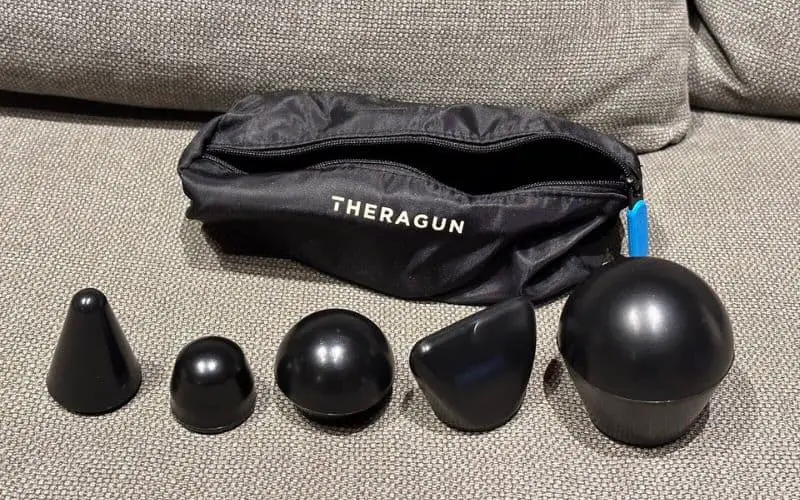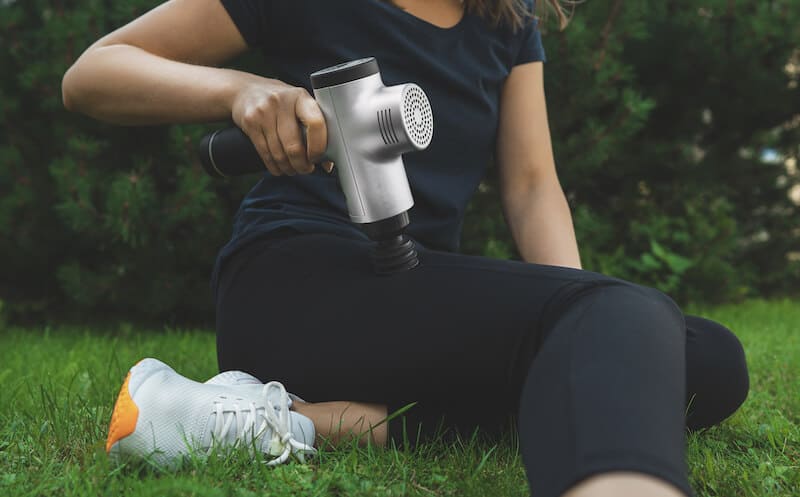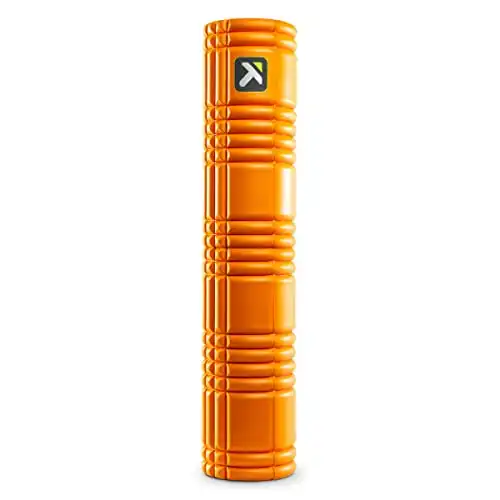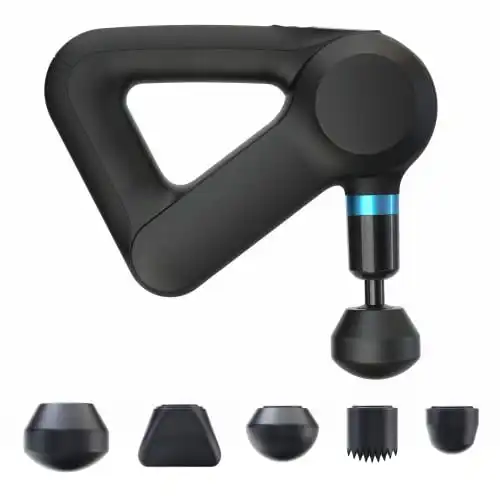Have you noticed that after a long day of riding, you can be aching for days? I found it to be quite frustrating…when can I ride again at a sub-par performance? Or worse yet, without causing injury?
We cyclists often push our limits, only to be met with stiff, sore muscles that no stretch can soothe. The solution isn’t just additional rest; it’s finding the best massage tools to improve recovery times.
Are massage tools the holy grail of recovery?
Summary of the Best Massage Tools For Cyclists
- Lightweight and compact
- Affordable
- Target specific areas with more precision than other tools
- 500lb weight limit
- Access to free instruction videos from the experts at TriggerPoint
- Designed to stand up to repeated use
- Trusted by professionals
- Convenient to use
- Premium build quality and feel
- Lots of attachments
- Increase blood circulation
- Lightweight design
- 100% vegan leather
- A relaxing way to massage your muscles
Reviews of the Best Self-Massage Tools
Massage Lacrosse Ball
- Solid rubber construction
- Inexpensive
- Doesn’t slip
- Bit awkward when using them on your back or neck
Let’s kick things off with a lacrosse ball…I know, it’s a simple concept, right?
These things are ideal for getting to those small knots you usually can’t reach. Muscles get knotty when riding and after your ride. Particularly on your shoulders, back, feet, and piriformis – this is where a lacrosse ball comes into play.
The lacrosse ball we’re looking at has a solid rubber construction, meaning that – when used correctly – you should see immediate results.
My shoulders and back can suffer a little after a long ride, and these lacrosse balls can ease my muscles and speed up my recovery. So, if you’re like me, I’d highly recommend this affordable solution.
One issue I have found with other lacrosse balls I’ve tried (I’ve even tried tennis balls. I’ll save you the trouble – don’t go there!) is that they are either too hard or too soft.
This means that they either don’t quite get deep enough or they are painful to use. This isn’t the case with these lacrosse balls. They get things spot on, don’t slip, and work well to ease the tension in your muscles.
These also come in some funky colors, which is nice!
Muscle Roller Stick
- Lightweight and compact
- Affordable
- Target specific areas with more precision than other tools
- Requires more effort from you
The idea behind a massage stick is that there are plastic rolling beads that will move along your body as you roll the stick. These beads will knead your body.
It’s a tool that is similar to a foam roller (which we will get onto later!), but I’d say that roller sticks are more helpful in working on your quads as you’re able to target specific areas more accurately.
There are, of course, many roller sticks out there, but this one should be the only one you need to buy. No, seriously, the manufacturer has used industrial-strength materials, so it is designed to last a lifetime.
That’s not the only thing I like about the durable design of this muscle roller stick. I love how compact it is, yet it still has nine spindles that work well to target sore muscles.
Some cyclists have found that using this muscle roller stick before and after a ride, rather than just after a ride, has increased their overall performance over time. This is because recovery is sped up, and the risk of injury is reduced.
For me, I’ve found the only downside (and it’s more my issue rather than the sticks) is that when I’m lacking in a bit of energy, it does take more effort than using a foam roller as you’re controlling the pressure with the roller stick, which is a good thing.
As I said, it’s more my issue than a fault with the stick itself, but it is something to keep in mind. If you’ve returned from a long ride, you might not have the energy to do the job properly!
If you have used a foam roller before, you will have noticed that you’re doing a lot of work to try and reach all the angles you need on a muscle, resulting in you getting into some awkward positions…hopefully, that’s not just me!
The difference with this particular model of muscle stick is its size. You can use it almost anywhere. I’m guilty of using it in bed. So long as you are working it along your quads in an up-and-down motion, it’s all good!
TriggerPoint Foam Roller
- 500lb weight limit
- Access to free instruction videos from the experts at TriggerPoint
- Designed to stand up to repeated use
- Trusted by professionals
- Some users may find it too firm initially
Foam rollers changed the way athletes recover, and they still dominate the recovery market. A foam roller will help to speed up the repair as it smooths out any knots and promotes blood flow.
This foam roller from TriggerPoint is made in the USA and is patented. It’s the first foam roller to feature a multi-density exterior constructed over a hollow core.
Sounds really impressive, right?
Basically, the pattern on the roller is ideal for dealing with tight muscles and knots. It’s also so good that many physical and massage therapists, coaches, trainers, and pro athletes use it.
Some foam rollers tend to lose their shape over time, so you aren’t getting the full benefit anymore. The TriggerPoint GRID 2.0 is different. It’s rigid and is going to hold up to repeated use. It will support up to 500 lbs, too, so it’s incredibly durable.
For some people, they may look at this foam roller and think it’s expensive for what it is. At first glance, I get what you’re saying. However! I have to say, the science behind this roller pays off.
It’s firm, so it withstands use, but it’s soft, so it’s a joy to use. It hits all the right places, and it certainly feels like an upgrade from any foam roller I’ve used before.
Want to know more about the science behind it all? Check out this video:
Theragun Elite
- Convenient to use
- Premium build quality and feel
- Lots of attachments
- Noisier than expected
- Pricey
Massage guns have grown in popularity over the years, and Theragun has been leading the charge.
For those unfamiliar with massage guns, they look like a smart power tool, but they’re a sports recovery tool. The head will oscillate at different speeds. In the Theragun Elite case, it’s five different speed settings, and this facilitates percussive therapy.
Without question, Theragun is up there as one of the more premium brands, and you get an impressive amount of features. Everything about the Theragun Elite performs as you’d expect; it does follow through with the premium feel the brand promises, and it feels like it will still be there for many years to come, making it a sound investment.
I particularly like that it has a Therabody companion app and a surprisingly long 120-minute battery life.
Theragun does claim that the Elite is quiet, and while it isn’t horribly noisy, it was louder than I expected. I wouldn’t go as far as to say it’s a reason not to buy it, but it’s something to keep in mind.
Massage guns beat a foam roller if you’re after accuracy, and you can use it while sitting on the sofa, so it does get huge convenience points.
As a cyclist, I can’t claim to have the strongest arms in the world (you know what I mean, don’t you?), but despite this, the weight of the Theragun Elite was well-balanced and never once felt challenging to use.

Shiatsu Back and Neck Massager
- Increase blood circulation
- Lightweight design
- 100% vegan leather
- A relaxing way to massage your muscles
- The heat function isn’t for everyone (but it can be switched off)
I first came across Shiatsu’s back and neck massager through a recommendation to simply de-stress, not as a recovery tool after cycling. However, if you’re someone like me who suffers particularly in the back, neck, and shoulders, then this could be ideal for you.
With this massager, you get four rotating heated nodes. They work to knead the knots away and get your blood circulation going.
After every minute, the nodes will change direction as you’d expect from a massage chair. This helps to prevent bruising and does help with removing the muscle tension as it gets you from different angles.
While the massage pillow is marketed for your back and neck, it’s versatile, and it can work on other parts of your body, such as your thighs, feet, arms, and shoulders (my favorite spot!).
One point I should make is that even though it may be tempting to use this for several cycles, I would urge against it. You will likely end up bruised and doing your muscles more harm than good. One cycle a day. Trust me 😉.
Why Is Massage Important For A Cyclists’ Recovery?
For any athlete, recovery is essential. It should form an integral part of your training and become part of your routine.
Recovery helps your body to regenerate and ultimately become more efficient. One way to ensure you recover properly is through massage. Massage helps muscles to relax and restore flexibility into your muscles.
When we exercise, we can damage our muscles, and recovery allows the body to heal these micro-lesions. Massage stimulates blood flow and helps to eliminate toxins – all good stuff for a proper recovery!
Remember, nutrition and stretching also play a key role in your recovery.
What To Look For In A Massage Tool
There are many different types of massage tools, and finding the right one can seem daunting.
I’d start by considering which areas you feel ache the most post-ride, as most tools are designed to work in one spot. In most cases, they can do other areas but not necessarily as effectively.
Think about whether you want something that will do the work for you. Remember that these tools won’t always be as precise as you, but they take away a lot of effort on your part.
If you’re happy to do some work, then you will be able to direct the massage tool where you want, so you may find that it’s more effective.

Why Is A Foam Roller Good For Cyclists?
As we know, as you work your muscles, tiny tears occur in the fibers, knots, and tight areas form. For cyclists, this is usually around the quad, hamstrings, and different parts of your back.
The repair process is vital to making you a stronger cyclist, and using a foam roller helps to speed up the repair process and also has many other benefits, such as:
- Your mobility and flexibility can increase
- Helps to prevent muscle pain as it relaxes your muscles
- Releases trigger points
- Helps you to maintain a proper muscle balance
Looking for some foam roller exercises? Check out this:
What To Do After A Massage
Taking steps to aid your recovery using a massage tool is great, but it doesn’t begin and end there!
I’d recommend doing a few light stretches so that your muscles can get back into their natural position. Depending on how time-pressed you are, you could even apply some ice to your muscles, as this helps to increase blood circulation further.
Don’t forget that a massage works your muscles, albeit gently, but it’s still a workout, so don’t plan to ride hard after you’ve had some massage time. Let your legs rest, and you should be good to go again tomorrow…but stronger!
By the way, if you’re new to the idea of recovery, you might want to check out this article on Recovery Ride vs Rest Days.
Frequently Asked Questions
What types of massage tools are most effective for treating IT band syndrome in cyclists?
For IT band syndrome, tools that provide targeted pressure, like foam rollers and massage sticks, are particularly effective.
Foam rollers can be used to roll out the length of the IT band, while massage sticks allow for more controlled pressure and can be easier to handle.
Regularly using these tools can help alleviate the tightness and pain associated with IT band syndrome, which is quite common among cyclists!
How often should cyclists use massage tools to gain the maximum benefits?
You should use massage tools as part of your regular training routine. Using tools like massage guns or foam rollers for a few minutes post-ride can significantly aid in recovery.
For preventive maintenance, using these tools 2-3 times a week is beneficial.
However, during periods of intense training or after particularly long rides, increasing the frequency to daily use can help manage muscle fatigue and soreness.
Can massage therapy tools help with injury prevention for cyclists?
Yes, massage therapy tools can play a significant role in injury prevention for cyclists.
By improving circulation and reducing muscle tightness, these tools help prepare the muscles for the demands of cycling and reduce the chances of overuse injuries.
Final Thoughts
OK, there we are, something to get you to become a stronger cyclist and help you to stay injury-free.
My personal favorite is the Muscle Roller Stick. It’s so portable, and you can target the areas you need to work on precisely, something not many other tools can claim.
When you have specific places you want to reach, then it’s ideal. For me, there’s nothing more frustrating than not being able to get to knotty muscles.
I love the build quality, and for something so affordable, it feels like it will last a lifetime.
For a cyclist, it hits all the right spots!
What areas of your body get tight after a day in the saddle?






